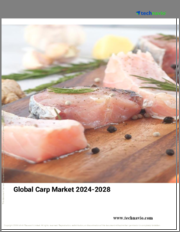
|
시장보고서
상품코드
1670780
잉어 시장 규모, 점유율, 성장 분석 : 품종별, 형태별, 유통 채널별, 지역별 - 산업 예측(2025-2032년)Carp Market Size, Share, and Growth Analysis, By Species (Grass, Silver), By Form (Frozen, Canned), By Distribution Channel, By Region - Industry Forecast 2025-2032 |
||||||
세계의 잉어 시장 규모는 2023년에 1,100억 달러로 평가되며, 2024년 1,161억 6,000만 달러에서 2032년까지는 1,796억 3,000만 달러로 성장하며, 예측 기간(2025-2032년)의 CAGR은 5.6%로 성장할 전망입니다.
잉어는 세계에서 인기 있는 물고기로 맛과 영양가가 높은 것으로 알려져 있으며, 식품, 반려동물, 레크리에이션 낚시 산업 등 다양한 시장 부문에 서비스를 제공합니다. 식품 분야는 시장을 선도하고 있으며, 잉어는 신선, 냉동, 통조림, 훈제 형태로 제공되며 유럽과 아시아의 전통 요리에 널리 활용되고 있습니다. 또한 잉어는 반려동물 사료의 주요 단백질 공급원으로서 반려동물 산업을 지원하고 있습니다. 잉어는 레크리에이션 낚시 분야도 활발히 이루어지고 있으며, 잉어는 도전적인 어획량으로 인정받고 있습니다. 경쟁 역학이 산업을 형성하고 있으며, 중국, 인도, 베트남과 같은 국가들이 주요 생산국으로 부상하고 있습니다. 미국 농무부 자료에 따르면 2020년 미국 잉어 수입은 9% 감소할 것으로 예상되며, 그 중 대부분이 중국에서 수입된 것으로 나타나 시장 행동의 변화를 보여줍니다.
목차
서론
- 조사의 목적
- 조사 범위
- 정의
조사 방법
- 정보 조달
- 2차와 1차 데이터 방법
- 시장 규모 예측
- 시장의 전제조건과 제한
개요
- 세계 시장 전망
- 공급과 수요 동향 분석
- 부문별 기회 분석
시장 역학과 전망
- 시장 개요
- 시장 규모
- 시장 역학
- 촉진요인과 기회
- 억제요인과 과제
- Porter의 산업 분석
주요 시장 인사이트
- 주요 성공 요인
- 경쟁의 정도
- 주요 투자 기회
- 시장 에코시스템
- 시장의 매력 지수(2024년)
- PESTEL 분석
- 거시경제 지표
- 밸류체인 분석
- 가격 분석
- 고객과 구매 기준 분석
잉어 시장 규모 : 품종별·CAGR(2025-2032년)
- 시장 개요
- Grass
- Silver
- Common
- Bighead
- Catla
- 기타
잉어 시장 규모 : 형태별·CAGR(2025-2032년)
- 시장 개요
- 냉동
- 통조림
잉어 시장 규모 : 유통 채널별·CAGR(2025-2032년)
- 시장 개요
- 하이퍼마켓·슈퍼마켓
- 편의점
- 온라인
- 기타
잉어 시장 규모·CAGR(2025-2032년)
- 북미
- 미국
- 캐나다
- 유럽
- 독일
- 스페인
- 프랑스
- 영국
- 이탈리아
- 기타 유럽 지역
- 아시아태평양
- 중국
- 인도
- 일본
- 한국
- 기타 아시아태평양
- 라틴아메리카
- 브라질
- 기타 라틴아메리카 지역
- 중동 및 아프리카
- GCC 국가
- 남아프리카공화국
- 기타 중동 및 아프리카
경쟁 정보
- 상위 5사의 비교
- 주요 기업의 시장 포지셔닝(2024년)
- 주요 시장 기업이 채택한 전략
- 최근 시장 동향
- 기업의 시장 점유율 분석(2024년)
- 주요 기업의 기업 개요
- 기업의 상세
- 제품 포트폴리오 분석
- 기업의 부문별 점유율 분석
- 매출의 전년대비 비교(2022-2024년)
주요 기업 개요
- Maruha Nichiro(Japan)
- Nissui(Japan)
- Mowi(Norway)
- Charoen Pokphand Foods(Thailand)
- VS Fisheries(United Kingdom)
- Hampshire Carp Hatcheries(United Kingdom)
- Dahu Aquaculture(China)
- Greenwater Fish Farm(United States)
- Baiyang Investment Group Inc.(China)
- Anhui Fuhuang Sungem Foodstuff Group Co. Ltd.(China)
결론과 제안
KSA 25.04.18Global Carp Market size was valued at USD 110.0 billion in 2023 and is poised to grow from USD 116.16 billion in 2024 to USD 179.63 billion by 2032, growing at a CAGR of 5.6% during the forecast period (2025-2032).
Carp is a globally popular fish, renowned for its taste and nutritional benefits, serving diverse market segments including food, pet, and recreational fishing industries. The food segment leads the market, with Carp available in fresh, frozen, canned, and smoked forms, widely utilized in traditional dishes across Europe and Asia. Additionally, Carp serves as a key protein source in pet food, supporting the pet industry. The recreational fishing segment also thrives, with Carp recognized for its challenging catch. Competitive dynamics shape the industry, with countries like China, India, and Vietnam emerging as major producers. According to USDA data, U.S. carp imports declined by 9% in 2020, largely sourced from China, highlighting shifting market behaviors.
Top-down and bottom-up approaches were used to estimate and validate the size of the Global Carp market and to estimate the size of various other dependent submarkets. The research methodology used to estimate the market size includes the following details: The key players in the market were identified through secondary research, and their market shares in the respective regions were determined through primary and secondary research. This entire procedure includes the study of the annual and financial reports of the top market players and extensive interviews for key insights from industry leaders such as CEOs, VPs, directors, and marketing executives. All percentage shares split, and breakdowns were determined using secondary sources and verified through Primary sources. All possible parameters that affect the markets covered in this research study have been accounted for, viewed in extensive detail, verified through primary research, and analyzed to get the final quantitative and qualitative data.
Global Carp Market Segments Analysis
Global Carp Market is segmented by Species, Form, Distribution Channel and region. Based on Species, the market is segmented into Grass, Silver, Common, Bighead, Catla and Others. Based on Form, the market is segmented into Frozen and Canned. Based on Distribution Channel, the market is segmented into Hypermarkets and Supermarkets, Convenience Store, Online and Others. Based on region, the market is segmented into North America, Europe, Asia Pacific, Latin America and Middle East & Africa.
Driver of the Global Carp Market
The global carp market is primarily driven by the rising demand for seafood and protein-rich diets. Carp is an affordable and readily accessible source of protein, appealing to a broad range of consumers. Furthermore, carp can be cultivated in diverse environments, showcasing their resilience and adaptability, which makes them a favored choice in aquaculture. As the world's population continues to expand, the need for protein-rich food is projected to surge, further propelling the growth of the carp market. This combination of affordability, availability, and sustainable farming practices positions carp as a key player in the global seafood industry.
Restraints in the Global Carp Market
A significant constraint facing the global carp market stems from the adverse effects carp have on aquatic ecosystems in various locations. As invasive species, carp can severely disrupt native fish populations and their habitats, triggering concerns about their introduction to new regions. This has resulted in stricter regulations on the transportation and sale of carp to mitigate ecological damage. Moreover, consumer hesitation to consume carp, largely rooted in their reputation as "bottom feeders," further influences market demand negatively. These factors collectively present challenges for the growth and expansion of the carp market in both established and emerging markets.
Market Trends of the Global Carp Market
The global carp market is experiencing a significant trend towards sustainable aquaculture, driven by heightened awareness of environmental issues and consumer demand for responsibly sourced seafood. Producers are increasingly adopting eco-friendly practices, including waste reduction, organic feeding, and enhanced water management, to mitigate their environmental footprint. This shift not only addresses concerns about fish farming's ecological impact but also aligns with the values of a growing segment of consumers who prioritize sustainability in their purchasing choices. As a result, the demand for sustainably farmed carp is surging, prompting industry players to innovate and optimize their operations to meet this trend.
Table of Contents
Introduction
- Objectives of the Study
- Scope of the Report
- Definitions
Research Methodology
- Information Procurement
- Secondary & Primary Data Methods
- Market Size Estimation
- Market Assumptions & Limitations
Executive Summary
- Global Market Outlook
- Supply & Demand Trend Analysis
- Segmental Opportunity Analysis
Market Dynamics & Outlook
- Market Overview
- Market Size
- Market Dynamics
- Drivers & Opportunities
- Restraints & Challenges
- Porters Analysis
- Competitive rivalry
- Threat of substitute
- Bargaining power of buyers
- Threat of new entrants
- Bargaining power of suppliers
Key Market Insights
- Key Success Factors
- Degree of Competition
- Top Investment Pockets
- Market Ecosystem
- Market Attractiveness Index, 2024
- PESTEL Analysis
- Macro-Economic Indicators
- Value Chain Analysis
- Pricing Analysis
- Customer & Buying Criteria Analysis
Global Carp Market Size by Species & CAGR (2025-2032)
- Market Overview
- Grass
- Silver
- Common
- Bighead
- Catla
- Others
Global Carp Market Size by Form & CAGR (2025-2032)
- Market Overview
- Frozen
- Canned
Global Carp Market Size by Distribution Channel & CAGR (2025-2032)
- Market Overview
- Hypermarkets and Supermarkets
- Convenience Store
- Online
- Others
Global Carp Market Size & CAGR (2025-2032)
- North America (Species, Form, Distribution Channel)
- US
- Canada
- Europe (Species, Form, Distribution Channel)
- Germany
- Spain
- France
- UK
- Italy
- Rest of Europe
- Asia Pacific (Species, Form, Distribution Channel)
- China
- India
- Japan
- South Korea
- Rest of Asia-Pacific
- Latin America (Species, Form, Distribution Channel)
- Brazil
- Rest of Latin America
- Middle East & Africa (Species, Form, Distribution Channel)
- GCC Countries
- South Africa
- Rest of Middle East & Africa
Competitive Intelligence
- Top 5 Player Comparison
- Market Positioning of Key Players, 2024
- Strategies Adopted by Key Market Players
- Recent Developments in the Market
- Company Market Share Analysis, 2024
- Company Profiles of All Key Players
- Company Details
- Product Portfolio Analysis
- Company's Segmental Share Analysis
- Revenue Y-O-Y Comparison (2022-2024)
Key Company Profiles
- Maruha Nichiro (Japan)
- Company Overview
- Business Segment Overview
- Financial Updates
- Key Developments
- Nissui (Japan)
- Company Overview
- Business Segment Overview
- Financial Updates
- Key Developments
- Mowi (Norway)
- Company Overview
- Business Segment Overview
- Financial Updates
- Key Developments
- Charoen Pokphand Foods (Thailand)
- Company Overview
- Business Segment Overview
- Financial Updates
- Key Developments
- VS Fisheries (United Kingdom)
- Company Overview
- Business Segment Overview
- Financial Updates
- Key Developments
- Hampshire Carp Hatcheries (United Kingdom)
- Company Overview
- Business Segment Overview
- Financial Updates
- Key Developments
- Dahu Aquaculture (China)
- Company Overview
- Business Segment Overview
- Financial Updates
- Key Developments
- Greenwater Fish Farm (United States)
- Company Overview
- Business Segment Overview
- Financial Updates
- Key Developments
- Baiyang Investment Group Inc. (China)
- Company Overview
- Business Segment Overview
- Financial Updates
- Key Developments
- Anhui Fuhuang Sungem Foodstuff Group Co. Ltd. (China)
- Company Overview
- Business Segment Overview
- Financial Updates
- Key Developments














